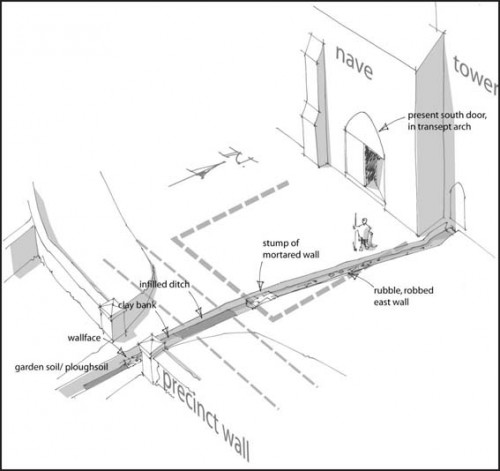County: Carlow Site name: St Lasarian’s Cathedral, Old Leighlin
Sites and Monuments Record No.: CW011-016 Licence number: 13E0055
Author: Dave Pollock
Site type: Medieval cathedral and town
Period/Dating: —
ITM: E 0m, N 0m
Latitude, Longitude (decimal degrees): 52.736451, -7.023440
Following an impact assessment and adjustments in the light of testing, a WC block and associated drainage were installed in 2013 at St Lasarian’s Cathedral, Old Leighlin, Co. Carlow.
The monitored excavation for a raft foundation under the WC block halted at the ground level of the 19th-century refurbishment. This ground level was a truncation, exposing two post-medieval skeletons and patches of the late medieval surface associated with construction of the adjacent chapel (present chapter room) and cathedral tower.
A service trench for the new drain was excavated by hand under the tower. The supports for a 19th-century wooden floor overlay part of a clay floor predating the refurbishment of the cathedral, at 0.48m below the present floor.
7m south of the cathedral the monitored drain trench exposed a piece of the gable wall of the former south transept. Rubble fill between the gable and the cathedral suggests a considerable drop in floor level between, or a basement under the transept. An in-filled ditch outside the transept gable is probably a relic of the medieval water supply.
In the graveyard extension, beyond the cathedral precinct, the trench for the new drain failed to penetrate the base of garden/field soil, but in the 50m run to the new septic tank the trench grazed subsoil and settlement remains. A building demolished in the 19th century is particularly late; most of the remains appear to be late medieval (based on a dearth of dateable material).
The footprint of the septic tank and percolation area was excavated as an archaeological trench, and found part of a robbed stone building cut into the hillside and into the silt of a pond or slow stream. The building was probably a watermill, and a dearth of pottery and clay pipes suggests a late medieval use. Samples of charred material may suggest a function for the mill, and may give a broad date.


Knockrower Road, Stradbally, Co. Waterford.